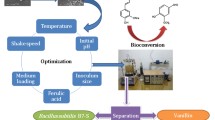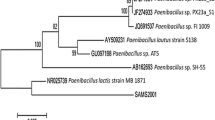Abstract
Pseudomonas fluorescens BF13 is especially capable of promoting the formation of vanillic acid during ferulic acid degradation. We studied the possibility of enhancing the formation of this intermediary metabolite by using suspensions of cells at high density. The bioconversion of ferulic into vanillic acid was affected by several parameters, such as the concentration of the biomass, the amount of ferulic acid that was treated, the carbon source on which the biomass was grown. The optimal yield of vanillic acid was obtained with 6 mg/ml cells pre-grown on p-coumaric acid and 2 mg/ml ferulic acid. Under these conditions the bioconversion rate was 95% in 5 h. Therefore BF13 strain represents a valid biocatalyst for the preparative synthesis of vanillic acid.
Similar content being viewed by others
Author information
Authors and Affiliations
Additional information
Received: 1 July 1997 / Received revision: 28 October 1997 / Accepted: 16 November 1997
Rights and permissions
About this article
Cite this article
Barghini, P., Montebove, F., Ruzzi, M. et al. Optimal conditions for bioconversion of ferulic acid into vanillic acid by Pseudomonas fluorescens BF13 cells. Appl Microbiol Biotechnol 49, 309–314 (1998). https://doi.org/10.1007/s002530051174
Issue Date:
DOI: https://doi.org/10.1007/s002530051174




